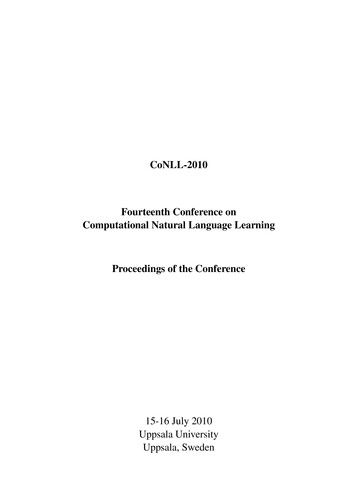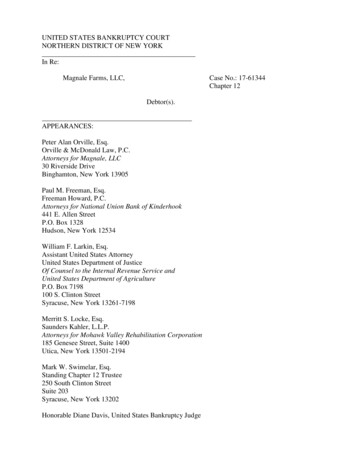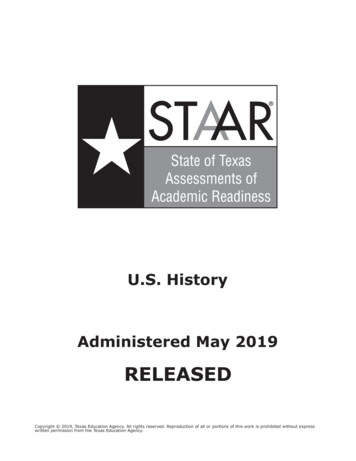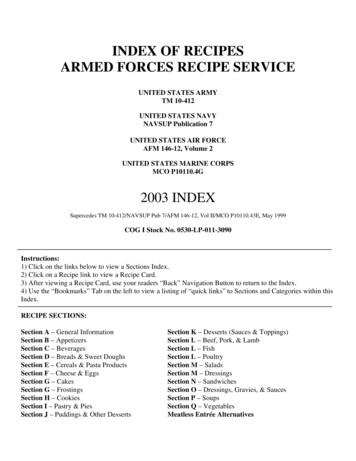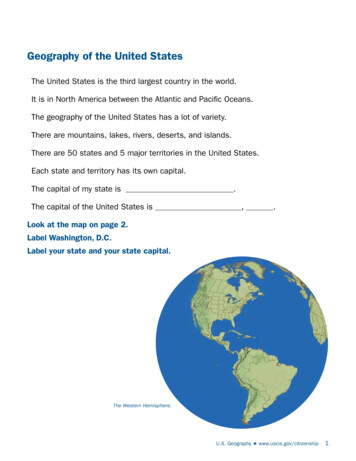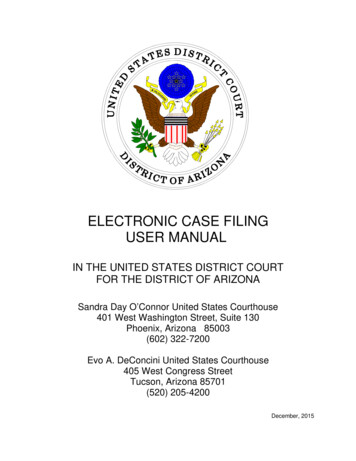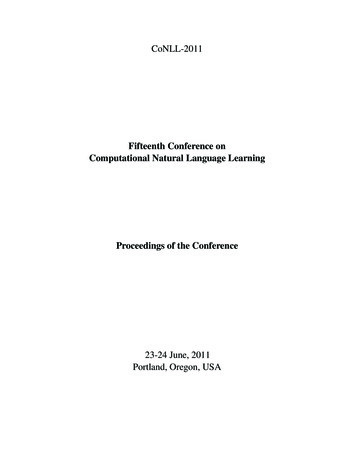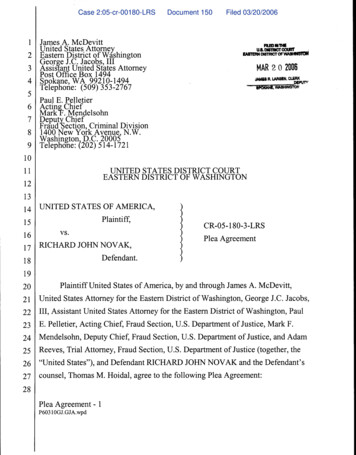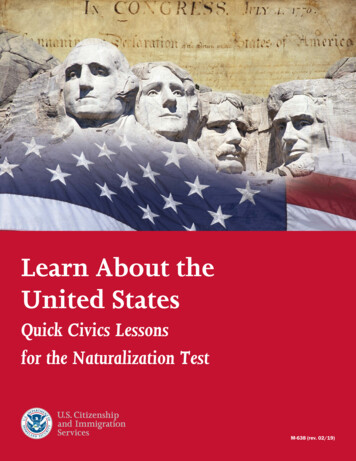
Transcription
Learn About theUnited StatesQuick Civics Lessonsfor the Naturalization TestM-638 (rev. 02/19)
Learn About the United States: Quick Civics LessonsThank you for your interest in becoming a citizen ofthe United States of America. Your decision to apply forU.S. citizenship is a very meaningful demonstration ofyour commitment to this country.As you prepare for U.S. citizenship, Learn About the UnitedStates: Quick Civics Lessons will help you study for the civicsand English portions of the naturalization interview.There are 100 civics (history and government) questionson the naturalization test. During your naturalizationinterview, you will be asked up to 10 questions fromthe list of 100 questions. You must answer correctly 6of the 10 questions to pass the civics test.Applicants who are age 65 or older and have been apermanent resident for at least 20 years at the time offiling the Form N-400, Application for Naturalization,are only required to study 20 of the 100 civics testquestions for the naturalization test. These questions areflagged with an asterisk (*) in this booklet.Learn About the United States contains short lessons basedon each of the 100 civics questions. This additionalinformation will help you learn more about importantconcepts in American history and government. Duringyour naturalization interview, you will not be testedon the additional information in the short lessons.There are three components to the English portion ofthe test: speaking, reading, and writing. Your ability tospeak English is determined by the USCIS Officer basedon your answers to questions normally asked during theeligibility interview on the Form N-400, Applicationfor Naturalization.For the reading test, you must read one (1) out of three(3) sentences correctly to demonstrate an ability to readin English. There is a reading vocabulary list with allthe words found in the English reading portion of thenaturalization test included in the back of this booklet.For the writing test, you must write one (1) out ofthree (3) sentences correctly to demonstrate an abilityto write in English. There is a writing vocabulary listwith all the words found in the English writing portionof the naturalization test included in the back of thisbooklet. IMPORTANT NOTE: On the naturalization test, someanswers may change because of elections or appointments.As you study for the test, make sure that you know themost current answers to these questions. Answer thesequestions with the name of the official who is servingat the time of your eligibility interview with USCIS. TheUSCIS Officer will not accept an incorrect answer. More Resources to Help You StudyVisit the USCIS Citizenship Resource Center atuscis.gov/citizenship to find additional educationalmaterials. Be sure to look for these helpful studytools: 100 Civics Questions and Answers for theNaturalization TestThe official list of civics questions and answersfor the naturalization test is available in English,Arabic, Chinese, Korean, Spanish, Tagalog, andVietnamese. The English version is also availablein large print and text-only format.Audio is available in English and Spanish. Civics Flash Cards for the Naturalization TestThese easy-to-use cards include each of the100 civics questions and answers on thenaturalization test. The Civics Flash Cards areavailable in English and Spanish. Preparing for the Oath: U.S. History andCivics for CitizenshipThis online resource provides videos andinteractive activities on the 100 civics questionsand answers. It also highlights museum objectsfrom the Smithsonian Institution. Civics Practice TestOnline study tool to help test your knowledgeof U.S. history and government.
The USCIS Naturalization Interview and TestVideoThis short video provides an overviewof the naturalization process and testingrequirements. The video highlights scenes fromthe naturalization interview, including thenaturalization test. Understanding Commands for theNaturalization InterviewThis activity has commands that you may hearduring the naturalization interview. Vocabulary for the Naturalization InterviewSelf-Test 1This reading activity has words and phrasesthat you may read on Form N-400, Applicationfor Naturalization, or hear during thenaturalization interview. Vocabulary for the Naturalization InterviewSelf-Test 2This reading and listening activity has wordsand phrases that you may read on Form N-400,Application for Naturalization, or hear duringthe naturalization interview. Find Help in Your CommunityFind an English and/or citizenship class orlegal assistance in your local area. Naturalization Information SessionsUSCIS regularly holds information sessionsfor the public to learn about naturalizationeligibility, testing, and citizenship rights andresponsibilities. Information in Other LanguagesFind USCIS citizenship publications andresources available in other languages as youprepare for U.S. citizenship.Hard copies of some of these products are availablefor purchase from the U.S. Government Bookstoreby calling 1-866-512-1800 (toll free) or byvisiting http://bookstore.gpo.gov
Civics TestLearn About the United StatesCivics Test AMERICAN GOVERNMENTIn the United States, the government gets its power to govern from the people. We have a government of thepeople, by the people, and for the people. Citizens in the United States shape their government and its policies, sothey must learn about important public issues and get involved in their communities. Learning about Americangovernment helps you understand your rights and responsibilities and allows you to fully participate in theAmerican political process. The Founders of this country decided that the United States should be a representativedemocracy. They wanted a nation ruled by laws, not by men. In a representative democracy, the people chooseofficials to make laws and represent their views and concerns in government. The following section will helpyou understand the principles of American democracy, the U.S. system of government, and the important rightsand responsibilities of U.S. citizenship. A: Principles of American Democracy1. What is the supreme law of the land? the ConstitutionThe Founding Fathers of the United States wrotethe Constitution in 1787. The Constitution is the“supreme law of the land.” The U.S. Constitution haslasted longer than any other country’s constitution.It establishes the basic principles of the United Statesgovernment. The Constitution establishes a systemof government called “representative democracy.”In a representative democracy, citizens chooserepresentatives to make the laws. U.S. citizens alsochoose a president to lead the executive branch ofgovernment. The Constitution lists fundamental rightsfor all citizens and other people living in the UnitedStates. Laws made in the United States must follow theConstitution.and state governments. The name for this divisionof power is “federalism.” Federalism is an importantidea in the Constitution. We call the Founding Fatherswho wrote the Constitution the “Framers” of theConstitution. The Framers wanted to limit the powersof the government, so they separated the powers intothree branches: executive, legislative, and judicial.The Constitution explains the power of each branch.The Constitution also includes changes and additions,called “amendments.” The first 10 amendmentsare called the “Bill of Rights.” The Bill of Rightsestablished the individual rights and liberties of allAmericans.3. The idea of self-government is in the first threewords of the Constitution. What are thesewords? We the PeopleThe Constitution says:2. What does the Constitution do? sets up the government defines the government protects basic rights of AmericansThe Constitution of the United States dividesgovernment power between the national government“We the People of the United States, in Order to form a more perfectUnion, establish Justice, insure domestic Tranquility, provide forthe common defence, promote the general Welfare, and secure theBlessings of Liberty to ourselves and our Posterity, do ordain andestablish this Constitution for the United States of America.” 1
Learn About the United StatesWith the words “We the People,” the Constitutionstates that the people set up the government. Thegovernment works for the people and protects therights of people. In the United States, the power togovern comes from the people, who are the highestpower. This is called “popular sovereignty.” Thepeople elect representatives to make laws.4. What is an amendment? a change (to the Constitution) an addition (to the Constitution)An amendment is a change or addition to theConstitution. The Framers of the Constitution knewthat laws can change as a country grows. They did notwant to make it too easy to modify the Constitution,the supreme law of the land. The Framers also did notwant the Constitution to lose its meaning. For thisreason, the Framers decided that Congress could passamendments in only two ways: by a two-thirds votein the U.S. Senate and the House of Representativesor by a special convention. A special convention hasto be requested by two-thirds of the states. After anamendment has passed in Congress or by a specialconvention, the amendment must then be ratified(accepted) by the legislatures of three-fourths of thestates. The amendment can also be ratified by a specialconvention in three-fourths of the states. Not allproposed amendments are ratified. Six times in U.S.history amendments have passed in Congress but werenot approved by enough states to be ratified.5. What do we call the first ten amendments to theConstitution? the Bill of RightsThe Bill of Rights is the first 10 amendments tothe Constitution. When the Framers wrote theConstitution, they did not focus on individual rights.They focused on creating the system and structureof government. Many Americans believed that theConstitution should guarantee the rights of thepeople, and they wanted a list of all the things agovernment could not do. They were afraid that astrong government would take away the rights peoplewon in the Revolutionary War. James Madison, oneof the Framers of the Constitution, wrote a list ofindividual rights and limits on the government. Theserights appear in the first 10 amendments, called theBill of Rights. Some of these rights include freedomof expression, the right to bear arms, freedom fromsearch without warrant, freedom not to be tried twicefor the same crime, the right to not testify againstyourself, the right to a trial by a jury of your peers, theright to an attorney, and protection against excessivefines and unusual punishments. The Bill of Rights wasratified in 1791.6. What is one right or freedom from the FirstAmendment?* speech religion assembly press petition the governmentThe First Amendment of the Bill of Rights protectsa person’s right to freedom of expression. Freedomof expression allows open discussion and debateon public issues. Open discussion and debate areimportant to democracy. The First Amendment alsoprotects freedom of religion and free speech. Thisamendment says that Congress may not pass lawsthat establish an official religion and may not limitreligious expression. Congress may not pass lawsthat limit freedom of the press or the right of peopleto meet peacefully. The First Amendment also givespeople the right to petition the government to changelaws or acts that are not fair. Congress may nottake away these rights. The First Amendment of theConstitution guarantees and protects these rights.7. How many amendments does the Constitutionhave? twenty-seven (27)The first 10 amendments to the Constitution arecalled the Bill of Rights. They were added in 1791.Since then, 17 more amendments have been added.The Constitution currently has 27 amendments. The27th Amendment was added in 1992. It explains howsenators and representatives are paid. Interestingly,Congress first discussed this amendment back in 1789as one of the original amendments considered for theBill of Rights. 2*If you are 65 or older and have been a permanent resident of the United States for 20 or more years,you may study just the questions marked with an asterisk.
Civics Test8. What did the Declaration of Independence do? announced our independence (from Great Britain) declared our independence (from Great Britain) said that the United States is free (from Great Britain)The Declaration of Independence contains importantideas about the American system of government. TheDeclaration of Independence states that all people arecreated equal and have “certain unalienable rights.”These are rights that no government can change ortake away. The author of the Declaration, ThomasJefferson, wrote that the American colonies shouldbe independent because Great Britain did not respectthe basic rights of people in the colonies. Jeffersonbelieved that a government exists only if the peoplethink it should. He believed in the idea that thepeople create their own government and consent,or agree, to follow laws their government makes.This idea is called “consent of the governed.” If thegovernment creates laws that are fair and protectpeople, then people will agree to follow those laws.In the Declaration of Independence, Jefferson wrotea list of complaints the colonists had against the Kingof England. Jefferson ended the Declaration with thestatement that the colonies are, and should be, free andindependent states. The Second Continental Congressvoted to accept the Declaration on July 4, 1776.9. What are two rights in the Declaration ofIndependence? life liberty pursuit of happinessThe Declaration of Independence lists three rights thatthe Founding Fathers considered to be natural and“unalienable.” They are the right to life, liberty, andthe pursuit of happiness. These ideas about freedomand individual rights were the basis for declaringAmerica’s independence. Thomas Jefferson and theother Founding Fathers believed that people are bornwith natural rights that no government can take away.Government exists to protect these rights. Because thepeople voluntarily give up power to a government,they can take that power back. The British governmentwas not protecting the rights of the colonists, so thecolonies took back their power and separated fromGreat Britain.Benjamin Franklin, John Adams, and Thomas Jefferson in“Writing the Declaration of Independence, 1776,” by Jean LeonGerome Ferris.Courtesy of the Library of Congress, LC-USZC4-9904.10. What is freedom of religion? You can practice any religion, or not practice areligion.Colonists from Spain, France, Holland, England, andother countries came to America for many differentreasons. One of the reasons was religious freedom. Therulers of many of these countries told their citizensthat they must go to a certain church and worship ina certain way. Some people had different religiousbeliefs than their rulers and wanted to have their ownchurches. In 1620, the Pilgrims were the first groupthat came to America seeking religious freedom.Religious freedom was also important to the Framers.For this reason, freedom of religion was included inthe Constitution as part of the Bill of Rights. The FirstAmendment to the Constitution guarantees freedom ofreligion. The First Amendment states, “Congress shallmake no law respecting an establishment of religion,or prohibiting the free exercise thereof.” The FirstAmendment also prohibits Congress from setting upan official U.S. religion, and protects citizens’ rights tohold any religious belief, or none at all.11. What is the economic system in the UnitedStates?* capitalist economy market economyThe economic system of the United States iscapitalism. In the American economy, most businessesare privately owned. Competition and profit motivatebusinesses. Businesses and consumers interact in themarketplace, where prices can be negotiated. This is 3
Learn About the United Statescalled a “market economy.” In a market economy,businesses decide what to produce, how much toproduce, and what to charge. Consumers decide what,when, and where they will buy goods or services. Ina market economy, competition, supply, and demandinfluence the decisions of businesses and consumers.12. What is the “rule of law”? Everyone must follow the law. Leaders must obey the law. Government must obey the law. No one is above the law.John Adams was one of the Founding Fathers andthe second president of the United States. He wrotethat our country is, “a government of laws, and notof men.” No person or group is above the law. Therule of law means that everyone (citizens and leaders)must obey the laws. In the United States, the U.S.Constitution is the foundation for the rule of law.The United States is a “constitutional democracy”(a democracy with a constitution). In constitutionaldemocracies, people are willing to obey the lawsbecause the laws are made by the people throughtheir elected representatives. If all people are governedby the same laws, the individual rights and libertiesof each person are better protected. The rule of lawhelps to make sure that government protects all peopleequally and does not violate the rights of certainpeople.B: System of Government13. Name one branch or part of the government.* Congress legislative President executive the courts judicialThe Constitution establishes three branches ofgovernment: legislative, executive, and judicial. ArticleI of the Constitution establishes the legislative branch.Article I explains that Congress makes laws. Congress(the Senate and the House of Representatives) is thelegislative branch of the U.S. government. Article IIof the Constitution establishes the executive branch.The executive branch enforces the laws that Congresspasses. The executive branch makes sure all the peoplefollow the laws of the United States. The president isthe head of the executive branch. The vice presidentand members of the president’s cabinet are also partof the executive branch. Article III of the Constitutionestablishes the judicial branch. The judicial branchplaces the highest judicial power in the SupremeCourt. One responsibility of the judicial branch isto decide if government laws and actions follow theConstitution. This is a very important responsibility.14. What stops one branch of government frombecoming too powerful? checks and balances separation of powersThe Constitution separates the government’s powerinto three branches to prevent one person or groupfrom having too much power. The separation ofgovernment into three branches creates a system ofchecks and balances. This means that each branch canblock, or threaten to block, the actions of the otherbranches. Here are some examples: the Senate (partof the legislative branch) can block a treaty signed bythe president (the executive branch). In this example,the legislative branch is “checking” the executive. TheU.S. Supreme Court (the judicial branch) can rejecta law passed by Congress (the legislative branch).In this example, the judicial branch is “checking”the legislative branch. This separation of powerslimits the power of the government and prevents thegovernment from violating the rights of the people.15. Who is in charge of the executive branch? the PresidentThe job of the executive branch is to carry out,or execute, federal laws and enforce laws passedby Congress. The head of the executive branch isthe president. The president is both the head ofstate and the head of government. The president’spowers include the ability to sign treaties with othercountries and to select ambassadors to represent theUnited States around the world. The president alsosets national policies and proposes laws to Congress.The president names the top leaders of the federaldepartments. When there is a vacancy on the Supreme 4*If you are 65 or older and have been a permanent resident of the United States for 20 or more years,you may study just the questions marked with an asterisk.
Civics TestCourt, the president names a new member. However,the Senate has the power to reject the president’schoices. This limit on the power of the president is anexample of checks and balances.16. Who makes federal laws? Congress Senate and House (of Representatives) (U.S. or national) legislatureCongress makes federal laws. A federal law usuallyapplies to all states and all people in the United States.Either side of Congress—the Senate or the House ofRepresentatives—can propose a bill to address an issue.When the Senate proposes a bill, it sends the bill to aSenate committee. The Senate committee studies theissue and the bill. When the House of Representativesproposes a bill, it sends the bill to a House ofRepresentatives committee. The committee studiesthe bill and sometimes makes changes to it. Then thebill goes to the full House or Senate for consideration.When each chamber passes its own version of thebill, it often goes to a “conference committee.” Theconference committee has members from both theHouse and the Senate. This committee discusses thebill, tries to resolve the differences, and writes a reportwith the final version of the bill. Then the committeesends the final version of the bill back to both housesfor approval. If both houses approve the bill, it isconsidered “enrolled.” An enrolled bill goes to thepresident to be signed into law. If the president signsthe bill, it becomes a federal law.17. What are the two parts of the U.S. Congress?* the Senate and House (of Representatives)Congress is divided into two parts—the Senateand the House of Representatives. Because it hastwo “chambers,” the U.S. Congress is known as a“bicameral” legislature. The system of checks andbalances works in Congress. Specific powers areassigned to each of these chambers. For example,only the Senate has the power to reject a treaty signedby the president or a person the president choosesto serve on the Supreme Court. Only the House ofRepresentatives has the power to introduce a bill thatrequires Americans to pay taxes.The Rotunda of the U.S. Capitol.Courtesy of the Architect of the Capitol.18. How many U.S. Senators are there? one hundred (100)There are 100 senators in Congress, two from eachstate. All states have equal power in the Senate becauseeach state has the same number of senators. Stateswith a very small population have the same numberof senators as states with very large populations. TheFramers of the Constitution made sure that the Senatewould be small. This would keep it more orderlythan the larger House of Representatives. As JamesMadison wrote in Federalist Paper #63, the Senate shouldbe a “temperate and respectable body of citizens” thatoperates in a “cool and deliberate” way.19. We elect a U.S. Senator for how many years? six (6)The Framers of the Constitution wanted senators tobe independent from public opinion. They thoughta fairly long, six-year term would give them thisprotection. They also wanted longer Senate terms tobalance the shorter two-year terms of the membersof the House, who would more closely follow publicopinion. The Constitution puts no limit on the numberof terms a senator may serve. Elections for U.S.senators take place on even-numbered years. Every twoyears, one-third of the senators are up for election. 5
Learn About the United States20. Who is one of your state’s U.S. Senators now?* Answers will vary. [District of Columbia residents andresidents of U.S. territories should answer that D.C.(or the territory where the applicant lives) has no U.S.Senators.]For a complete list of U.S. senators and the states theyrepresent, go to senate.gov.21. The House of Representatives has how manyvoting members? four hundred thirty-five (435)The House of Representatives is the larger chamber ofCongress. Since 1912, the House of Representativeshas had 435 voting members. However, thedistribution of members among the states has changedover the years. Each state must have at least onerepresentative in the House. Beyond that, the numberof representatives from each state depends on thepopulation of the state. The Constitution says that thegovernment will conduct a census of the populationevery 10 years to count the number of people in eachstate. The results of the census are used to recalculatethe number of representatives each state should have.For example, if one state gains many residents thatstate could get one or more new representatives. Ifanother state loses residents, that state could loseone or more. But the total number of voting U.S.representatives does not change.22. We elect a U.S. Representative for how manyyears? two (2)People who live in a representative’s district are called“constituents.” Representatives tend to reflect theviews of their constituents. If representatives do notdo this, they may be voted out of office. The Framersof the Constitution believed that short two-year termsand frequent elections would keep representativesclose to their constituents, public opinion, andmore aware of local and community concerns. TheConstitution puts no limit on the number of terms arepresentative may serve. All representatives are up forelection every two years.23. Name your U.S. Representative. Answers will vary. [Residents of territories withnonvoting Delegates or Resident Commissioners mayprovide the name of that Delegate or Commissioner.Also acceptable is any statement that the territory hasno (voting) Representatives in Congress.]For a complete list of U.S. representatives and thedistricts they represent, go to house.gov.24. Who does a U.S. Senator represent? all people of the stateSenators are elected to serve the people of their statefor six years. Each of the two senators representsthe entire state. Before the 17th Amendment to theConstitution was ratified in 1913, the state legislatureselected the U.S. senators to represent their state. Now,all the voters in a state elect their two U.S. senatorsdirectly.25. Why do some states have more Representativesthan other states? (because of) the state’s population (because) they have more people (because) some states have more peopleThe Founding Fathers wanted people in all states tobe represented fairly. In the House of Representatives,a state’s population determines the number ofrepresentatives it has. In this way, states with manypeople have a stronger voice in the House. In theSenate, every state has the same number of senators.This means that states with few people still have astrong voice in the national government.26. We elect a President for how many years? four (4)Early American leaders thought that the head of theBritish government, the king, had too much power.Because of this, they limited the powers of the headof the new U.S. government. They decided that thepeople would elect the president every four years. 6*If you are 65 or older and have been a permanent resident of the United States for 20 or more years,you may study just the questions marked with an asterisk.
Civics TestThe president is the only official elected by the entirecountry through the Electoral College. The ElectoralCollege is a process that was designed by the writersof the Constitution to select presidents. It came froma compromise between the president being electeddirectly by the people and the president being chosenby Congress. Citizens vote for electors, who thenchoose the president. Before 1951, there was nolimit on the number of terms a president could serve.With the 22nd Amendment to the Constitution, thepresident can only be elected to two terms (four yearseach) for a total of eight years.27. In what month do we vote for President?* NovemberThe Constitution did not set a national election day.In the past, elections for federal office took place ondifferent days in different states. In 1845, Congresspassed legislation to designate a single day for allAmericans to vote. It made Election Day the Tuesdayafter the first Monday in November. Congress choseNovember because the United States was mostly rural.By November, farmers had completed their harvestsand were available to vote. Another reason for this datewas the weather. People were able to travel because itwas not yet winter. They chose Tuesday for ElectionDay so that voters had a full day after Sunday to travelto the polls.28. What is the name of the President of the UnitedStates now?* Visit uscis.gov/citizenship/testupdates for the name ofthe President of the United States.For more information about the president of theUnited States, visit whitehouse.gov.29. What is the name of the Vice President of theUnited States now? Visit uscis.gov/citizenship/testupdates for the name ofthe Vice President of the United States.The inauguration of President Theodore Roosevelt on March 4, 1905.Courtesy of the Library of Congress, LC-USZ62-231.30. If the President can no longer serve, whobecomes President? the Vice PresidentIf the president dies, resigns, or cannot work whilestill in office, the vice president becomes president.For this reason, the qualifications for vice presidentand president are the same. A vice president becamepresident nine times in U.S. history when thepresident died or left o
Arabic, Chinese, Korean, Spanish, Tagalog, and Vietnamese. The English version is also available in large print and text-only format. Audio is available in English and Spanish. Civics Flash Cards for the Naturalization Test These easy-to-use cards include each of the 100




